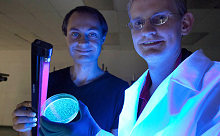|
 A controversy brews over the merits of breeding
plants that glow like a lightning bug. Proponents say glowing trees could eventually
replace electric street lights, thereby reducing pollution created by generating
stations. Opponents say messing around with tree genes is dangerous and should be
disallowed since it could lead to unanticipated environmental ramifications on both
plant and animal species. The unique aspect of this effort is that it is being pursued
primarily by genetic hobbyists rather than corporations - at least for now. There
is bound to be a huge financial potential for such a copyrighted line of plants.
My opposition to the concept is primarily a concern for light pollution projected
skyward. Astronomers have a difficult enough time with ever-encroaching sources
of ambient light, but a planet overrun by cross-bred and mutated glowing plants
(and possibly animals), especially if they are capable of emitting levels high enough
to replace street lights, would effectively blind billions of dollars of investments
in telescopes. A controversy brews over the merits of breeding
plants that glow like a lightning bug. Proponents say glowing trees could eventually
replace electric street lights, thereby reducing pollution created by generating
stations. Opponents say messing around with tree genes is dangerous and should be
disallowed since it could lead to unanticipated environmental ramifications on both
plant and animal species. The unique aspect of this effort is that it is being pursued
primarily by genetic hobbyists rather than corporations - at least for now. There
is bound to be a huge financial potential for such a copyrighted line of plants.
My opposition to the concept is primarily a concern for light pollution projected
skyward. Astronomers have a difficult enough time with ever-encroaching sources
of ambient light, but a planet overrun by cross-bred and mutated glowing plants
(and possibly animals), especially if they are capable of emitting levels high enough
to replace street lights, would effectively blind billions of dollars of investments
in telescopes.
 You have probably seen the images of light
levels from across the face of the Earth, with the greatest levels emanating from
the world's population centers. A century ago universities were able to construct
telescopes at the back of their campuses, away from main operational areas. Nowadays,
even with expensive optical filters that block spectral lines from manmade terrestrial
sources like high and low pressure sodium lights, halogen lights, mercury vapor
lights, etc., there is still far too much background illumination to see dim objects.
Most stars and nebulas emit in the same wavelengths as our artificial lighting,
so filtering street light filters star light as well. You have probably seen the images of light
levels from across the face of the Earth, with the greatest levels emanating from
the world's population centers. A century ago universities were able to construct
telescopes at the back of their campuses, away from main operational areas. Nowadays,
even with expensive optical filters that block spectral lines from manmade terrestrial
sources like high and low pressure sodium lights, halogen lights, mercury vapor
lights, etc., there is still far too much background illumination to see dim objects.
Most stars and nebulas emit in the same wavelengths as our artificial lighting,
so filtering street light filters star light as well.
Thanks to a massive effort on the part of astronomers - both professional and
amateur - laws have been passed limiting the amount of light that can be released
skyward by outdoor lighting. Baffles are installed around the perimeter as necessary
to reduce skyward light emission. Still, light levels are overwhelming and increasing.
A good night in my backyard with a clear sky, no moon, and low humidity allows
me to see stars down to around 12th magnitude with my 8"
Celestron CPC800 telescope. Nebulas disappear at about 10th magnitude.
With high humidity the seeing is diminished by 2-4 magnitudes. On a rainy or snowy
night I can literally read a book by the ambient light. The situation is causing
me to give serious consideration to moving (yet again) to an area south of Erie
that has darker skies.
In a worst case scenario where mutations and cross-breeding causes trees, shrubs,
bugs, and critters to collectively put off a large amount of light would not have
the benefit of baffles to limit skyward-directed light. Telescopes in the middle
of a desert or at the top of a mountain (above the timber line) might still be useful,
but otherwise astronomers would be in real trouble.
Posted October 15, 2021
(updated from original post on 5/8/2013)
|
 "
"
